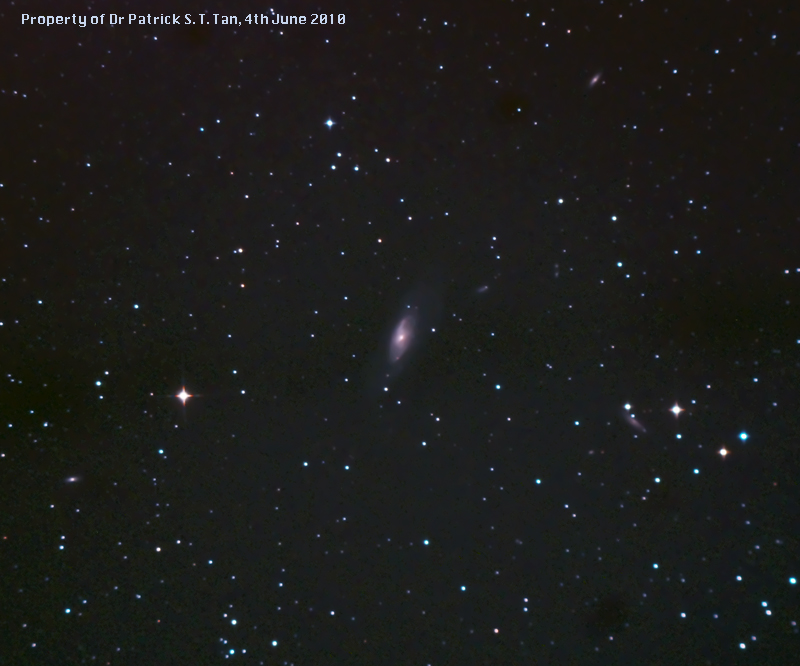
M106, NGC 4248, 4217, 4346, 4224
Date: 04/06/10 Time: 2330hrs Location: Sunningwell Temperature: 18.8ºC Relative Humidity: 64%
Camera: Nikon D80 Scope: William Optics Z66 Apo Doublet at prime focus Mount: piggy-backed on Meade LX90 in equatorial mode Filter: Astronomik CLS (LPF broadband filter) Exposures: 9x10min, ISO: 1600 F ratio: 5.9 Guidance: Autoguided
M106 is a barred-spiral galaxy in the constellation Canes venatici (the hunting dogs) and can be located halfway on a line drawn between Phecda in Ursa major and β-canes venaticorum. It is relatively bright in the night sky at magnitude +8 and should therefore be visible as a faint grey fuzzy with large binoculars or a modest refractor. M106 is a type 2 Seyfert galaxy - defined as galaxies with intensely bright (both in optical and higher frequencies) galactic cores, the radiation of which contains bright spectral emission lines of hydrogen, helium, oxygen and nitrogen. These may be a mixture of narrow and broad lines, (Type 1) or predominantly narrow spectral lines (Type 2), the difference between which is probably a result of the viewing angle, with the more side-on galaxies losing their broad emission spectra through dispersion in dust-lanes. The high electromagnetic radiation from the galactic nucleus is thought to be due to ionised gas falling into a supermassive black hole at the galactic core, hence the doppler broadening of the energy emission as it accelerates across the accretion disc. This region is rich in galaxies and one can see very faintly, NGC4248 to the right of M106, NGC4217 to the lower right, NGC4224 at the top right and NGC4346 at the lower left.
Summer observing is rarely satisfying - short light nights with the sun barely below the northern horizon all night and high humidity resulting in poor transparency. This picture is very far from what it should be. 4 of the 10 minute exposures were reduced in quality by a reduction in transparency probably due to mist or very fine, high cloud which of course picks up ambient night light. By the time the dense light pollution colour was removed from the final product, much of the galaxy detail has also been degraded or removed. The first 2 and last 2 of the 10 minute exposures suffered from this problem and so the light pollution subtraction was carried out in three separate groups of stacked images - the first 2, the middle 5, and the last 2, each of which had a different 'shade' of light pollution based on how dense the mist was at the time (2330hrs to 0300hrs). Then the 3 subtracted images were stacked and the usual black and white point setting was done in Photoshop to stretch the dynamic range and midtone enhancement was taken to the very maximum before the photograph became too 'solarised'. A single pass of Noise Ninja at higher settings for smoothness and unsharp masking was carried out before cropping and resizing.
HOME Archive Pictures: Narrow field PICTURES: Solar system PICTURES: Wide field